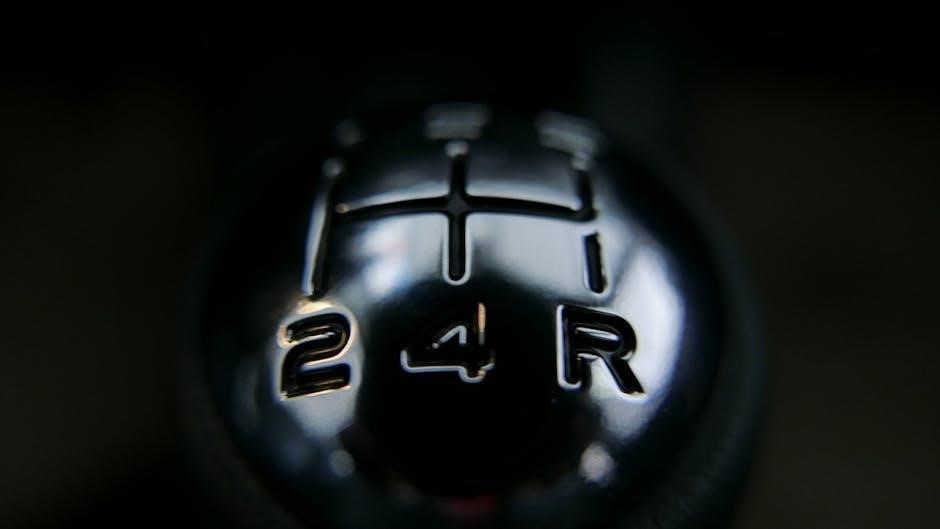pros and cons of a manual transmission
A manual transmission‚ also known as a stick shift‚ is a drivetrain system that requires the driver to manually shift gears using a clutch pedal and gearshift․ It offers greater driver engagement‚ better fuel efficiency‚ and lower costs‚ making it a popular choice for many․ However‚ it demands more skill and effort compared to automatic transmissions‚ especially in heavy traffic․ This system provides enhanced control over the vehicle but can be less convenient in certain driving conditions․
Pros of Manual Transmissions
Manual transmissions offer better fuel efficiency‚ lower purchase and maintenance costs‚ and greater driver engagement․ They provide a more enjoyable driving experience‚ improved acceleration‚ and even serve as a potential anti-theft deterrent;
Better Fuel Efficiency
Manual transmissions are widely recognized for their superior fuel efficiency compared to automatic transmissions․ By allowing drivers to have full control over gear shifts‚ manual transmissions minimize unnecessary fuel consumption․ This is particularly beneficial in urban driving conditions‚ where frequent acceleration and deceleration can significantly impact fuel economy․ Additionally‚ manual transmissions typically lack the torque converter found in automatics‚ which can drain fuel efficiency․ Studies and driver experiences consistently show that manual vehicles often achieve better mileage per gallon‚ especially in city driving․ Over time‚ this can lead to noticeable savings on fuel costs․ Furthermore‚ the ability to optimize gear usage according to driving conditions ensures that the engine operates more efficiently‚ reducing overall fuel waste․ This makes manual transmissions a practical choice for environmentally conscious drivers and those seeking to lower their expenses․
Lower Purchase and Maintenance Costs
Manual transmissions are generally more affordable to purchase and maintain compared to automatic transmissions․ The simpler design of manual gearboxes reduces production costs‚ making manual vehicles less expensive for consumers․ Additionally‚ manual transmissions require less complex components‚ such as torque converters and hydraulic systems‚ which are found in automatics․ This simplicity translates to lower maintenance and repair costs over time․ For instance‚ replacing a manual transmission clutch is often less expensive than repairing or replacing an automatic transmission․ Furthermore‚ manual transmissions do not require specialized fluids or filters‚ further reducing long-term expenses․ This cost-effectiveness makes manual transmissions a practical choice for budget-conscious drivers․ The financial benefits extend beyond the initial purchase‚ as owners can save money on upkeep and repairs․ This affordability is one of the key reasons manual transmissions remain a popular option for many car buyers seeking value and reliability․
Greater Driver Engagement and Control
Manual transmissions provide drivers with a heightened sense of engagement and control over their vehicle․ By manually shifting gears using the clutch pedal and gearshift‚ drivers are more actively involved in the driving process․ This direct connection to the car’s mechanics fosters a more immersive and enjoyable driving experience․ The ability to choose the optimal gear for specific situations‚ such as climbing hills or merging onto highways‚ gives drivers greater command over the vehicle’s performance․ Additionally‚ manual transmissions encourage drivers to pay closer attention to their surroundings‚ reducing distractions and enhancing focus․ This level of control is particularly appealing to driving enthusiasts who value the tactile feedback and precision of shifting gears․ The interaction between the driver‚ clutch‚ and gearbox creates a more dynamic and rewarding experience‚ making manual transmissions a favorite among those who enjoy driving as an art rather than a necessity․
Enhanced Driving Experience and Fun

Driving a manual transmission vehicle offers an unparalleled sense of enjoyment and connection to the road․ The act of shifting gears and controlling the clutch creates a more interactive and immersive experience‚ making driving feel more like an art than a chore․ Many enthusiasts argue that manual transmissions allow for a deeper bond between the driver and the car‚ as the driver must actively participate in the process․ The tactile feedback of the gearshift and the satisfaction of executing smooth shifts contribute to a more engaging and rewarding drive․ Additionally‚ the ability to control acceleration and deceleration through gear selection enhances the thrill of driving‚ especially on winding roads or during spirited driving․ This sense of control and involvement makes manual transmissions a favorite among driving purists who value the joy and satisfaction of driving as much as the destination itself․
Improved Acceleration and Performance
Manual transmissions often provide better acceleration and performance compared to automatics; By allowing the driver to manually control gear shifts‚ a manual transmission enables precise optimization of engine speed and torque delivery․ This direct control means drivers can keep the engine within its optimal power band‚ especially during acceleration‚ resulting in quicker responsiveness and smoother power delivery․ Additionally‚ manual transmissions typically weigh less and have fewer mechanical complexities than automatics‚ which can improve overall vehicle performance․ The ability to downshift before entering a turn or upshift at the perfect moment enhances driving dynamics‚ making manual transmissions a preferred choice for enthusiasts and performance-oriented drivers․ This level of control and efficiency is why manual transmissions are often paired with sports and high-performance vehicles‚ where acceleration and responsiveness are critical․
Potential Anti-Theft Deterrent
One unique advantage of manual transmissions is their potential to act as a theft deterrent․ Since not all drivers are familiar with or skilled in operating a manual gearbox‚ thieves may find it difficult to drive a vehicle equipped with one․ This can make manual transmission cars less appealing to potential thieves compared to automatics‚ which are generally easier to operate․ While modern vehicles often come with advanced security systems‚ the manual transmission adds an extra layer of difficulty for unauthorized individuals․ However‚ it’s important to note that this is not a foolproof security measure‚ as determined thieves may still find ways to steal the vehicle․ Nonetheless‚ for drivers who value this added layer of inconvenience for potential thieves‚ a manual transmission can offer a subtle yet practical benefit․ This feature is particularly appealing for those who prioritize both driving engagement and a touch of added security․

Cons of Manual Transmissions
Manual transmissions require more driver effort‚ especially in heavy traffic‚ and can lead to fatigue․ They also have a steeper learning curve and limited availability in modern vehicles‚ making them less convenient for some drivers․

Steeper Learning Curve for New Drivers
One of the most significant drawbacks of manual transmissions is the steep learning curve they present for new drivers․ Mastering the coordination between the clutch pedal and gearshift requires time and practice‚ often leading to initial frustration․ Novice drivers must learn to balance clutch engagement with accelerator input‚ especially when starting from a standstill or navigating uphill․ This can result in stalling the vehicle repeatedly until the skill is refined․ Additionally‚ the constant need to shift gears in varying driving conditions demands attention and coordination‚ which can be overwhelming for inexperienced drivers․ While some may adapt quickly‚ others may find the process challenging and time-consuming․ This difficulty in learning can deter many from choosing manual transmission vehicles‚ especially in regions where automatics are more common and traffic conditions are demanding․

Increased Driver Fatigue in Heavy Traffic
Manual transmissions can lead to increased driver fatigue‚ particularly in heavy traffic conditions․ Constantly shifting gears and operating the clutch pedal requires sustained physical and mental effort‚ which can be exhausting over time․ In stop-and-go traffic‚ drivers must repeatedly press and release the clutch‚ shift between low gears‚ and maintain focus to avoid stalling․ This repetitive motion can strain the leg muscles and lead to discomfort during long commutes․ Additionally‚ the need to remain alert and engaged with the vehicle’s gear changes reduces the opportunity for the driver to relax‚ even in slow-moving traffic․ While manual transmissions offer greater control‚ the continuous effort required in congested areas can make driving more tiring compared to automatic transmissions‚ which handle gear shifts automatically and allow the driver to focus less on the mechanics of driving․
Limited Availability in Modern Vehicles
Manual transmissions have become less common in modern vehicles‚ with many automakers prioritizing automatic and continuously variable transmissions (CVTs) due to their ease of use and adaptability to diverse driving conditions․ This trend is particularly evident in SUVs‚ sedans‚ and luxury vehicles‚ where automatic transmissions dominate the market․ The decline in manual transmission availability is partly due to shifting consumer preferences‚ as many drivers favor the convenience and comfort of automatic systems‚ especially in urban and traffic-heavy environments․ Additionally‚ advancements in automatic transmissions have narrowed the performance and fuel-efficiency gaps that once made manuals more appealing․ While manual transmissions are still offered in some sports cars and niche models‚ their overall availability has diminished‚ limiting options for enthusiasts who prefer the tactile experience of driving a stick shift․ This reduction in availability reflects broader industry trends toward automation and convenience in the automotive sector․
Clutch Wear and Tear Over Time
One notable drawback of manual transmissions is the gradual wear and tear on the clutch mechanism‚ which can lead to increased maintenance costs over time․ The clutch‚ a critical component that facilitates smooth gear transitions‚ is subject to degradation due to frequent engagement and disengagement․ Aggressive driving habits‚ such as riding the clutch or abrupt shifting‚ can accelerate wear․ Over time‚ this can result in a spongy clutch pedal‚ difficulty shifting gears‚ and eventually‚ the need for costly repairs or replacement․ While clutch replacement intervals vary depending on driving conditions and behavior‚ it remains a common maintenance concern for manual transmission vehicles․ This issue underscores the importance of proper driving techniques and regular maintenance to extend the lifespan of the clutch and ensure optimal performance of the manual transmission system․ Despite these challenges‚ many drivers find the benefits of manual transmissions worth the extra upkeep․
Less Convenience in Stop-and-Go Situations
Manual transmissions can be less convenient in stop-and-go traffic‚ as they require constant engagement with the clutch and gearshift․ In heavy traffic‚ drivers must frequently press and release the clutch pedal‚ shift gears‚ and coordinate with the accelerator‚ which can be tiring and frustrating․ This repetitive process increases driver fatigue‚ especially in urban areas where traffic lights and congestion are common․ Additionally‚ the need to manually manage the transmission reduces the ability to relax during the commute‚ unlike automatic transmissions‚ which handle gear shifts seamlessly․ While manual transmissions excel in open-road driving‚ their demand for constant input makes them less practical for drivers who frequently encounter stop-and-go conditions․ This trade-off between control and convenience is a key consideration for those deciding between manual and automatic transmissions‚ particularly for city driving or commutes in densely populated areas․
Compatibility Issues with Certain Driving Conditions
Manual transmissions can present challenges in specific driving conditions‚ particularly in hilly or mountainous terrains․ Constantly shifting gears and using the clutch to avoid rolling backward on steep inclines can lead to clutch wear and driver fatigue․ Additionally‚ in snowy or icy conditions‚ manual transmissions require precise control to prevent wheelspin‚ which can be difficult for inexperienced drivers․ While modern manual transmissions often include features like hill-start assist to mitigate these issues‚ they still demand more skill and attention in challenging environments․ Furthermore‚ in regions with frequent construction zones or uneven road surfaces‚ the constant need to shift gears can become cumbersome․ These compatibility issues highlight why automatic transmissions are often preferred in areas with challenging terrain or extreme weather conditions․ Despite these drawbacks‚ many drivers find the benefits of manual transmissions worth the trade-off in ideal driving conditions․

